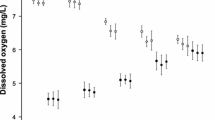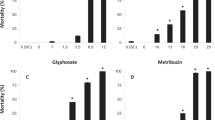Abstract
Despite the higher diversity of amphibians and the increasing use of agrochemicals in tropical countries, knowledge on the ecotoxicity of such compounds to tropical amphibians remains very limited. The aim of this study was, therefore, to assess the acute lethal toxicity of three nitrogen salts (ammonium sulphate, sodium nitrate and sodium nitrite) to tadpoles of five tropical frog species: Rhinella ornata, Boana faber, B. pardalis, Physalaemus cuvieri, and P. olfersii. The order of sensitivity to the nitrogen salts for all five species was sodium nitrite > ammonium sulphate > sodium nitrate. There was not a single most sensitive species to all three nitrogen salts. However, differences in generated 4-d LC50 values between the most and least sensitive test species were small (a factor 2 to 6). A comparison with published toxicity values does not suggest an intrinsic higher, or lower, sensitivity of the tropical species tested as compared to their temperate counterparts. Reported nitrogen concentrations in sugarcane fields do not indicate a lethal risk to the amphibian species tested. Chronic-exposure and field studies are recommended to evaluate amphibian sensitivity under environmental-realistic multiple-stressor conditions.


Similar content being viewed by others
References
Aldenberg T, Jaworska JS (2000) Uncertainty of hazardous concentrations and fraction affected for normal species sensitivity distributions. Ecotoxicol Environ Saf 46:1–18
APHA (2005) Standard methods for the examination of water and wastewater, 21st edn. American Public Health Association, Washington, DC, USA
ASTM (2013) Standard guide for conducting the frog embryo teratogenesis assay—Xenopus (FETAX). ASTM E1439-12. American Society for Testing and Materials, West Conshohocken, PA, USA
Araújo CVM, Shinn C, Moreira-Santos M, Lopes I, Espindola ELG, Ribeiro R (2014) Copper-driven avoidance and mortality in temperate and tropical tadpoles. Aquat Toxicol 146:70–75
Baird DJ, Barber I, Bradley M, Calow P, Soares AMVM (1989) The Daphnia bioassay: a critique. Hydrobiologia 188(189):403–406
Baker J, Waights V (1994) The effects of nitrate on tadpoles of the tree frog (Litoria caerulea). Herpetol J 4:106–108
Bantle JA, Dumont JN, Finch R, Linder G (1991) Atlas of abnormalities: a guide for the performance of FETAX. Oklahoma State University, Stillwater, USA
Bellezi L, Ilha P, Schiesari L (2015) Ontogenetic variation in the sensitivity of the gladiator frog, Hypsiboas faber, to inorganic nitrogen. Copeia 103:14–21
Camargo JA, Alonso A (2006) Ecological and toxicological effects of inorganic nitrogen pollution in aquatic ecosystems: a global assessment. Environ Int 32:831–849
Casali-Pereira MP, Daam MA, Resende JC, Vasconcelos AM, Espíndola ELG, Botta CM (2015) Toxicity of Vertimec® 18 EC (active ingredient abamectin) to the neotropical cladoceran Ceriodaphnia silvestrii. Chemosphere 139:558–564
Daam MA, Moutinho MF, Espíndola ELG, Schiesari L (2019) Lethal toxicity of the herbicides acetochlor, ametryn, glyphosate and metribuzin to tropical frog larvae. Ecotoxicology 28:707–715
EPA (2002) Methods for measuring the acute toxicity of effluents and receiving waters to freshwater and marine organisms, 5th edn. Environmental Protection Agency, Washington, DC
Gosner KL (1960) A simplified table for staging anuran embryos and larvae with notes on identification. Herpetologica 16:183–190
Hamilton MA, Russi RC, Thurston RV (1977) Trimmed Spearman–Karber method for estimating median lethal concentrations in toxicity bioassays. Environ Sci Technol 11:714–719
Hegde G, Krishnamurthy SV, Berger G (2019) Common frogs response to agrochemicals contamination in coffee plantations, Western Ghats, India. Chem Ecol 35:397–407
Ilha P, Schiesari L (2014) Lethal and sublethal effects of inorganic nitrogen on gladiator frog tadpoles (Hypsiboas faber, Hylidae). Copeia 2014:221–230
IUCN (2017) IUCN Red list of threatened species, v 2017. 3. International Union for Conservation of Nature, Gland, Switzerland, http://www.iucnredlist.org
Liu Z, Tai P, Li X, Kong L, Matthews TG, Lester RE, Mondon JA (2019) Deriving site-specific water quality criteria for ammonia from national versus international toxicity data. Ecotoxicol Environ Saf 171:665–676
Luo S, Wu B, Xiong X, Wang J (2016) Short‐term toxicity of ammonia, nitrite, and nitrate to early life stages of the rare minnow (Gobiocypris rarus). Environ Toxicol Chem 35:1422–1427
Marco A, Quilchano C, Blaustein AR (1999) Sensitivity to nitrate and nitrite in pond-breeding amphibians from the Pacific Northwest. Environ Toxicol Chem 18:2836–2839
Martinelli LA, Filoso S (2008) Expansion of sugarcane ethanol production in Brazil: environmental and social challenges. Ecol Appl 18:885–898
Mooney TJ, Pease CJ, Hogan AC, Trenfield M, Kleinhenz LS, Humphrey C, van Dam RA, Harford AJ (2019) Freshwater chronic ammonia toxicity: a tropical-to-temperate comparison. Environ Toxicol Chem 38:177–189
OECD (2015) Test No. 241: the larval amphibian growth and devel- opment assay (LAGDA). Organisation for Economic Cooperation and Development, Paris
Ortiz-Santaliestra ME, Maia JP, Egea-Serrano A, Lopes I (2018) Validity of fish, birds and mammals as surrogates for amphibians and reptiles in pesticide toxicity assessment. Ecotoxicology 27:819–833
Ortiz-Santaliestra ME, Marco A, Fernández MJ, Lizana M (2006) Influence of developmental stage on sensitivity to ammonium nitrate of aquatic stages of amphibians. Environ Toxicol Chem 25:105–111
Sańchez-Domene D, Navarro-Lozano A, Acayaba R, Picheli K, Montagner C, Rossa-Feres DC, da Silva FR, de Almeida EA (2018) Eye malformation baseline in Scinax fuscovarius larvae populations that inhabit agroecosystem ponds in southern Brazil. Amphib–Reptilia 39:325–334
Schiesari L, Corrêa DT (2016) Consequences of agroindustrial sugarcane production to freshwater biodiversity. GCB Bioenergy 8:644–657
Schiesari L, Grillitsch B, Grillitsch H (2007) Biogeographic biases in research and their consequences for linking amphibian declines to pollution. Conserv Biol 21:465–471
Schuytema GS, Nebeker AV (1999) Comparative effects of ammonium and nitrate compounds on Pacific treefrog and African clawed frog embryos. Arch Environ Contam Toxicol 36:200–206
Shinn C, Marco A, Serrano L (2008) Inter- and intra-specific variation on sensitivity of larval amphibians to nitrite. Chemosphere 71:507–514
Sparling DW, Linder G, Bishop C, Krest S (2010) Ecotoxicology of amphibians and reptiles. SETAC/Taylor & Francis, Boca Raton, FL
Sprague JB (1985) Factors that modify toxicity. In: Rand GM, Petrocelli SR (eds.) Fundamentals of aquatic toxicology. Hemi-sphere, Washington, DC, p 124–163
Tilak KS, Lakshmi SJ, Susan TA (2002) The toxicity of ammonia, nitrite and nitrate to the fish, Catla catla (Hamilton). J Environ Biol 23:147–149
Valencia-Aguilar A, Corteś-Gómez AM, Ruiz-Agudelo CA (2013) Ecosystem services provided by amphibians and reptiles in Neotropical ecosystems. Int J Biodivers Sci Ecosyst Serv Manag 9:257–272
Valencia-Castañeda G, Frías-Espericueta MG, Vanegas-Pérez RC, Chávez-Sánchez MC, Páez-Osuna F (2019) Toxicity of ammonia, nitrite and nitrate to Litopenaeus vannamei juveniles in low-salinity water in single and ternary exposure experiments and their environmental implications. Environ Toxicol Pharmacol 70:103193
Van Vlaardingen P, Traas TP, Wintersen AM, Aldenberg T (2004) ETX 2.0. A program to calculate hazardous concentrations and fraction affected, based on normally distributed toxicity data. RIVM Report No. 601501028/2004. National Institute of Public Health and the Environment (RIVM), Bilthoven, the Netherlands
Verdade VK, Carnaval AC, Rodrigues MT, Sciesari LC, Pavan D, Bertoluci JA (2011) Decline of amphibians in Brazil. In: Heatwole H, Wilkinson JW (eds.) Amphibian biology. Status of decline of amphibians: Western Hemisphere. Part 2: Uruguay, Brazil, Ecuador and Colombia. Surrey Beatty and Sons, Chipping Norton, Australia, p 85–127
Wang N, Dorman RA, Ivey CD, Soucek DJ, Dickinson A, Kunz BK, Steevens JA, Hammer EJ, Bauer CR (2020) Acute and chronic toxicity of sodium nitrate and sodium sulfate to several freshwater organisms in water‐only exposures. Environ Toxicol Chem 39:1071–1085
Wang Z, Leung KMY (2015) Effects of unionised ammonia on tropical freshwater organisms: implications on temperate-to-tropic extrapolation and water quality guidelines. Environ Pollut 205:240–249
Whitfield SM, Lips KR, Donnelly MA (2016) Amphibian decline and conservation in central America. Copeia 104:351–379
Williams EM, Eddy FB (1986) Chloride uptake in freshwater teleosts and its relationship to nitrite uptake and toxicity. J Comp Physiol B 156:867–87
Zar J (1999) Biostatiscal analysis. Upper Saddle River Prentice Hall, New Jersey, USA
Acknowledgements
We thank ICMBio (ICMBio 17559) and the Museu de Zoologia da Universidade de São Paulo for collection permits, Coordenação de Aperfeiçoamento de Pessoal de Nível Superior (CAPES) for a scholarship to PI, and Conselho Nacional de Desenvolvimento Tecnológico (CNPq Edital Universal Projeto 483801/2007-0) and the São Paulo Research Foundation (FAPESP Young Researcher Award 2008/57939-9, FAPESP Thematic Project 2015/ 18790-3) for funding this research. This work was also supported by the Portuguese government (FCT) through the research unit UIDB/04085/2020 (CENSE).
Author information
Authors and Affiliations
Corresponding author
Ethics declarations
Conflict of interest
The authors declare that they have no conflict of interest.
Ethical approval
All applicable international, national, and/or institutional guidelines for the care and use of animals were followed. The permit for collection, transport and storage of the test animals used in this study was provided by IBAMA/ICMBio (permit number 17559-1) and the tests conducted were approved by the ethical Commission of the Instituto de Biocien̂cias da Universidade de São Paulo (Protocol 039/2007).
Additional information
Publisher’s note Springer Nature remains neutral with regard to jurisdictional claims in published maps and institutional affiliations.
Rights and permissions
About this article
Cite this article
Daam, M.A., Ilha, P. & Schiesari, L. Acute toxicity of inorganic nitrogen (ammonium, nitrate and nitrite) to tadpoles of five tropical amphibian species. Ecotoxicology 29, 1516–1521 (2020). https://doi.org/10.1007/s10646-020-02247-8
Accepted:
Published:
Issue Date:
DOI: https://doi.org/10.1007/s10646-020-02247-8




